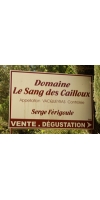Wine from Le Sang des Cailloux

Le Sang des Cailloux Estate
One glimpse of Serge Férigoule’s barbell moustache might be enough for one to be completely enamored with the wines of Le Sang des Cailloux, although they also speak remarkably well for themselves. This domaine’s name means “the blood of the stones,” and Serge Férigoule is most certainly the heart that links the two together. In 1974, Serge left winemaking school with a longing to return to the vineyards. He went to work for Monsieur Ricard’s family in 1979 to oversee the vineyards. Without anyone in his family to succeed him, Ricard decided to gamble by partnering with Serge in 1982. In 1990, after Monsieur Ricard’s retirement, Serge launched Le Sang des Cailloux. Vacqueyras had just been awarded an A.O.C. that same year, a timely twist of fate that helped Serge’s wines to become as celebrated as they deserve.
Le Sang des Cailloux Vineyards
All of Serge’s seventeen hectares rest on the great Plateau des Garrigues, where red clay, limestone, and the famous galets roulés, or rounded stones, impart a terrific intensity and depth to the wines. Given the aridity of the soil, the vines here are naturally prone to lower yields—this gives the wines their concentration and power. That Serge has been farming organically for years but has never sought certification says something about his philosophy. He is not looking to impress; only to make the best wines he possibly can. Serge is also sentimental—each year, the Cuvée Traditionnelle of Le Sang des Cailloux is named for one of his daughters, Floureto, Doucinello and Azalaïs. The “Vieilles Vignes” is also called “Lopy,” named for his hometown. His wines have everything we love about the Rhône – wild and chewy with great notes of leather, spicy garrigue, and smoky, black fruit.
No products found
- back
Selected Options
Wineries
Categories
Pricing
Countries
Regions
Grape Types
Wineries
Organic/Free Shipping
Aalto P.S. Pagos Seleccionados Tinto is made from 100 percent Tempranillo.
Climatic conditions
The farming year began with a mild autumn and little precipitation. A very dry winter started with -9ºC reaching at the end higher temperatures than normal for that time of the year. Spring and summer characterized by little rain, only some rain showers in July and late August avoided the hydric stress of the vines. The vegetative cycle of the vine developed with big variations of temperatures, alternating warm and atypical low temperatures of 4ºC for mid-June. The ripening of the grapes happened under very good conditions and the harvest started on 24th September 2019.
Grape origin
100% Tinto Fino (Tempranillo) primarily from very old vines – 60 to 90 years old – from selected plots in La Horra and La Aguilera. The harvest was done by hand, in small boxes of 15 kilos that are thoroughly inspected, bunch by bunch, on the selection table.
Tasting notes
Average oak ageing
Aged for 21 months in new French oak barrels.
Review:
Lots of depth here, with ripe blackberries and some nicely baked black cherries, roasted herbs, incense, dark spices, mussels and a balsamic tinge. An admirably fine dollop of tannins on the palate, which are immaculate and juicy, as they thoroughly dunk into the black fruit, melting into a persistent finish that lasts for over a minute. Very impressive. Drink or hold.
-James Suckling 96 Points
Hailing from 1937, these certified organic vines are some of the most unique we’ve ever seen. Just a mile and a half from the Napa border on the Sonoma side of the Mayacamas, located in what is the new Moon Mountain AVA, the vines are planted along steep, contoured terraces. Finding old vineyards is rare enough, but ancient hillside head-trained vines located 1000 feet up? Downright extraordinary.
Review:
"The 2022 Zinfandel Fredericks Vineyard is medium to deep ruby in the glass. It opens slowly but steadily with multifaceted aromas of peach skin, dried red berries, dark spices, wafts of cooling botanicals and a lifted, vibrant floral perfume. The full-bodied palate is suave, concentrated and polished, hiding rustic but gentle tannins and seamless, mineral-tinged acidity with its long, perfumed finish. As with much of the 2022 Turley Zinfandels, this should unwind and come into itself after 3-5 years in bottle and provide more than a decade of enjoyment in the cellar."
- 94 Points Robert Parker




